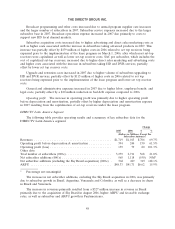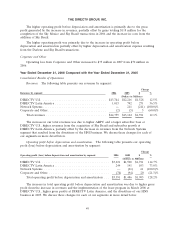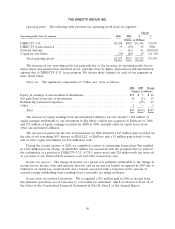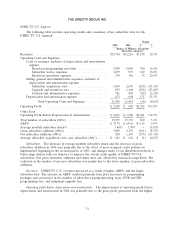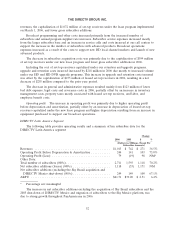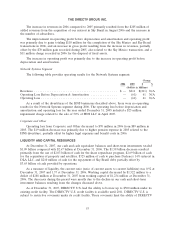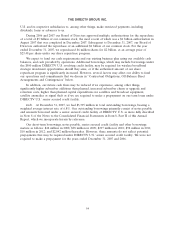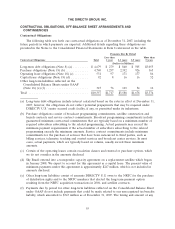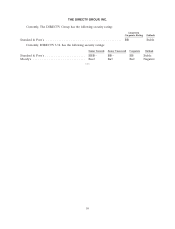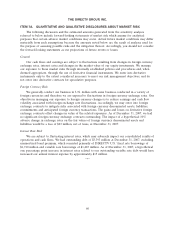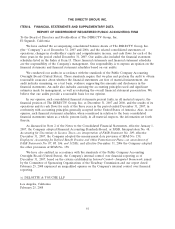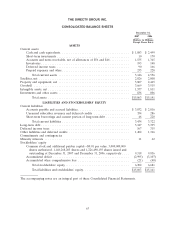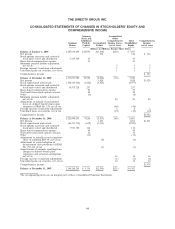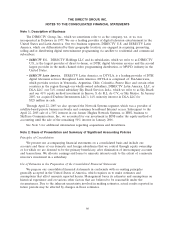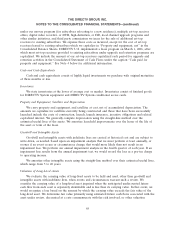DIRECTV 2007 Annual Report Download - page 67
Download and view the complete annual report
Please find page 67 of the 2007 DIRECTV annual report below. You can navigate through the pages in the report by either clicking on the pages listed below, or by using the keyword search tool below to find specific information within the annual report.THE DIRECTV GROUP, INC.
We completed our annual impairment testing during the fourth quarter of 2007, and determined that
there was no impairment of goodwill or intangible assets with indefinite lives.
The goodwill evaluation requires the estimation of the fair value of reporting units where we
record goodwill. We determine fair values primarily using estimated cash flows discounted at a rate
commensurate with the risk involved, when appropriate. Estimation of future cash flows requires
significant judgment about future operating results, and can vary significantly from one evaluation to
the next. Risk adjusted discount rates are not fixed and are subject to change over time. As a result,
changes in estimated future cash flows and/or changes in discount rates could result in a write-down of
goodwill or intangible assets with indefinite lives in a future period which could be material to our
consolidated results of operations and financial position.
Recognition of Rebate Related to Long-Term Purchase Agreement. As part of our sale of HNS’
set-top receiver manufacturing operations to Thomson in June 2004, DIRECTV U.S. entered into a
long-term purchase agreement with Thomson for the supply of set-top receivers. As part of this
agreement, as amended, DIRECTV U.S. can earn a $57 million rebate from Thomson if Thomson’s
aggregate sales of DIRECTV U.S.’ set-top receivers equal at least $4 billion over the initial five-year
contract term plus an additional one-year optional extension period, or the Contract Term. DIRECTV
U.S. has determined that, based upon projected set-top receiver requirements, it is probable and
reasonably estimable that the minimum purchase requirement will be met for the $57 million rebate
during the Contract Term. DIRECTV U.S. bases its probability assessment for meeting the minimum
purchase requirement on its current and future business projections, including its belief that existing
and new subscribers will likely acquire new set-top receivers due to certain technological advances. Any
negative trends in the purchase of set-top receivers for existing and new subscribers may materially
impact its ability to earn the rebate. On a quarterly basis, DIRECTV U.S. assesses whether the rebate
is probable over the Contract Term. If DIRECTV U.S. subsequently determines that it is no longer
probable that it will earn the rebate, DIRECTV U.S. would be required to reverse the amount of the
credit recognized to date as a charge to the Consolidated Statements of Operations and an increase in
the capitalized value of leased set-top receivers at the time such determination is made.
ACCOUNTING CHANGES AND NEW ACCOUNTING PRONOUNCEMENTS
For a discussion of accounting changes and new accounting pronouncements see Note 2 of the
Notes to the Consolidated Financial Statements in Part II, Item 8 of this Annual Report, which we
incorporate herein by reference.
SECURITY RATINGS
Debt ratings by the various rating agencies reflect each agency’s opinion of the ability of issuers to
repay debt obligations as they come due and expected loss given a default. Ratings in the Baa range for
Moody’s Investors Service and the BBB range for Standard & Poor’s Ratings Services, or S&P,
generally indicate adequate current protection of interest payments and principal security, with certain
protective elements lacking. Ratings in the Ba range for Moody’s and the BB range for S&P, generally
indicate moderate protection of interest and principal payments, potentially outweighed by exposure to
uncertainties or adverse conditions. In general, lower ratings result in higher borrowing costs. A
security rating is not a recommendation to buy, sell, or hold securities and may be subject to revision
or withdrawal at any time by the assigning rating organization.
58


